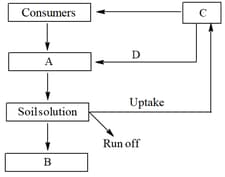EASY
Earn 100
Select the pairs of sedimentary biogeochemical cycles.
I. Hydrogen cycle and water cycle
II. Phosphorus Cycle and sulphur cycle
III. Calcium cycle and magnesium cycle
IV. Carbon cycle and nitrogen cycle
(a)I and II
(b)II and III
(c)III and IV
(d)I and IV
50% studentsanswered this correctly
Important Questions on Ecosystem
EASY
EASY
HARD
EASY
MEDIUM
EASY
Fill in the blank with the correct option from the bracket.
The major reservoir of carbon on Earth is _____. (soil, ocean, atmosphere)
EASY
MEDIUM
MEDIUM
EASY
MEDIUM
Match the following concerning essential elements and their functions in plants
| (a) | Iron | (i) | Photolysis of water |
| (b) | Zinc | (ii) | Pollen germination |
| (c) | Boron | (iii) | Required for chlorophyll biosynthesis |
| (d) | Manganese | (iv) | IAA biosynthesis |
Select the correct option.
EASY
EASY
Which one of the following element never goes to the atmosphere?
EASY
Given below is a simplified model of phosphorus cycling in a terrestrial ecosystem with four blanks (A-D). Identify the blanks.


